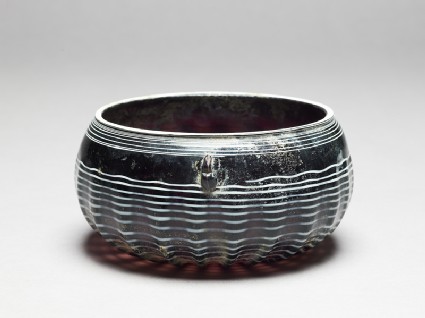Room 31 | Islamic Middle East gallery
Explore artefacts made over a period of more than 1000 years in the heart of the Islamic world.

Galleries : 258 objects
- Reference URL
Actions
Marvered glass bowl
-
Description
Marvering is a hot-worked glass technique in which decorative trails of molten glass are applied to a vessel by rolling it on a marver - a flat stone or iron surface. A technique developed by the Romans, Marvered glass continued to be used throughout late antiquity for various kinds of objects, from everyday vessels, to cosmetic flasks, and even weights. In the Islamic world, the production of marvered glass appears to have peaked during the 12th and 13th century in Syria and Egypt, from where most of the extant vessels seem to originate.
-
Details
- Associated place
- Date
- 12th - 13th century (1101 - 1300)
- Material and technique
- glass, free-blown and shaped in a mould, with marvered decoration in white
- Dimensions
-
7.5 cm (height)
15.1 cm (diameter)
- Material index
- Technique index
- Object type index
- No. of items
- 1
- Credit line
- Purchased with the assistance of the Friends of the Ashmolean Museum, 1975.
- Accession no.
- EA1975.18
-
Further reading
Newby, Martine S., Glass of Four Millennia, Ashmolean Handbooks (Oxford: Ashmolean Museum, 2000), no. 29 on p. 38, illus. p. 39 fig. 29
London: Hayward Gallery, 8 April-4 July 1976, The Arts of Islam, Dalu Jones and George Michell, eds (London: Arts Council of Great Britian, 1976), no. 144 on p. 146
Allan, James, ‘Investigations into Marvered Glass: I’, James Allan, ed., Islamic Art in the Ashmolean Museum, Part One, Oxford Studies in Islamic Arts, 10 (Oxford: Oxford University Press, 1995), x.1, no. 2 on p. 25, pp.1 & 6-7, illus. p. 2 fig. 1
Glossary
marvered
-
marvered
Decorative glass created by rolling hot and malleable glass over a flat surface known as marver, to create smooth sides or to consolidate applied decoration.
Location
Objects are sometimes moved to a different location. Our object location data is usually updated on a monthly basis. Contact the Jameel Study Centre if you are planning to visit the museum to see a particular object on display, or would like to arrange an appointment to see an object in our reserve collections.
Galleries
Notice
Objects may have since been removed or replaced from a gallery. Click into an individual object record to confirm whether or not an object is currently on display. Our object location data is usually updated on a monthly basis, so contact the Jameel Study Centre if you are planning to visit the museum to see a particular Eastern Art object.
© 2013 University of Oxford - Ashmolean Museum







